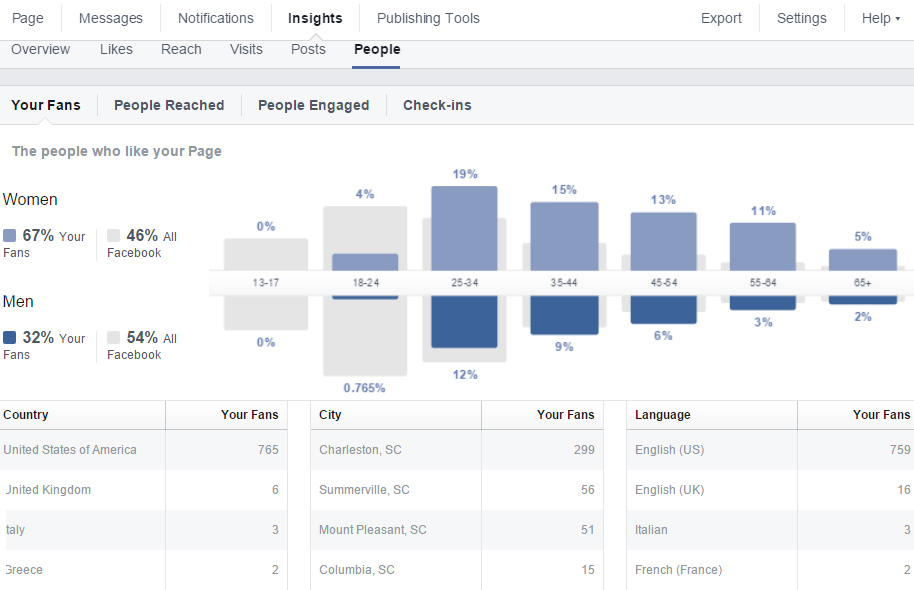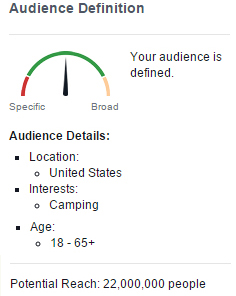The best ad in the world will only be effective if the right audience is seeing it.
Facebook offers many powerful ways to hone in on the consumers that matter most to your business. You can use them to get even more granular by targeting not just your general audience, but specific audience segments.
Few businesses have just one type of customer. It’s likely that you cater to people with different types of needs; each of these different customer types is an audience segment. You can divide your audience up by a wide range of factors – such as demographics, psychographics, communication/media behaviors, or how they use your product – whatever helps you to better align your message with their needs.
So how do you get down to those specifics? Here’s a step-by-step guide.
Step 1: Know Your Audience
You need to know your general audience before you can start defining segments. Gather as much data as possible about your current customers. Good sources of information include looking at Google Analytics from your website, gathering zip codes from in-store customers, and running surveys either on paper or online.
And of course, use your common sense. If you sell camping equipment, it’s likely that your customers enjoy camping! No need for research there.
Make Use of Your Insights Tab
Facebook also provides you with information about your current page fans that can be valuable when reaching out to more people. To view this data, go to your Facebook page and select the “Insights” tab, then go to the “People” sub-tag.
You’ll find data about the gender, country, city, and language of your current fans, people you’ve reached, people who’ve engaged with your posts, and people who checked in with your business. Depending on how much activity you have on your page, you can find a wealth of data, and you should consider each of these audiences differently.
If you are looking to gain more customers like your current customers, then the data about current fans can be valuable, but those who have engaged with your posts or checked in at your business are clearly more active and connected with your brand. The data from those two tabs may prove to be more accurate and valuable when targeting your ads and putting your business in front of people who will convert.
Step 2: Understand Your Targeting Options
There are four main categories with multiple options underneath them. Exploring and understanding what’s available can help you uncover ideas for segmentation that will be best suited to Facebook’s current functionality.
To help you do that, we’ve listed all of the current options here, but they may change and expand over time.
- Location. You can narrow down your audience by country, state/province, city, and zip code.Another important feature: you can exclude locations. Don’t overlook this option. Online businesses can use it to remove locations that they don’t ship to. Brick and mortar businesses can use it to hone in on where their customers are truly coming from. Zip code research can go a long way here. You can include a 50 mile radius around your store, but through your zip code research, you may uncover a zip code within that range that simply doesn’t drive customers. Don’t waste your money there – exclude it.
- Demographics. There are many options available, which are listed below:
- Age
- Gender
- Languages
- Relationship
- Interested In:
- Men
- Women
- Men and Women
- Unspecified
- Relationship Status:
- Single
- In a Relationship
- Married
- Engaged
- Unspecified
- Civil Union
- Domestic Partnership
- Open Relationship
- Complicated
- Separated
- Divorced
- Widowed
- Education
- Education Level:
- Associate degree
- College Grad
- Doctorate Degree
- High School Grad
- In College
- In Grad School
- In High School
- Master’s Degree
- Professional Degree
- Some College
- Some High School
- Some Grad School
- Unspecified
- Fields of Study
- Schools
- Undergrad Years
- Education Level:
- Work
- Employer
- Job Title
- Industries:
- Administrative
- Architecture and Engineering
- Arts, Entertainment, Sports and Media
- Business and Financial Operations
- Cleaning and Maintenance
- Community and Social Services
- Computer and Mathematics
- Construction and Extraction
- Education and Library
- Farming, Fishing and Forestry
- Food Preparation and Services
- Healthcare and Medical
- IT and Technical
- Installation and Repair
- Legal
- Management
- Military
- Personal Care
- Production
- Protective Service
- Retail
- Sales
- Science
- Temporary and Seasonal
- Transportation and Moving
- Office Type:
- Home Office
- Small Business
- Small Office
- Financial
- Income:
- $40,000 – $50,000
- $50,000 – $75,000
- $75,000 – $100,000
- $100,000 – $125,000
- $125,000 – $150,000
- $150,000 – $250,000
- $250,000 – $350,000
- $350,000 – $500,000
- Over $500,000
- Net Worth:
- $1 – $100,000
- $100,000 – $200,000
- $200,000 – $500,000
- $500,000 – $750,000
- $750,000 – $1,000,000
- $1,000,000 – $2,000,000
- Over $2,000,000
- Home
- Home Type:
- Apartment
- Condo
- Multi-Family Home
- Single
- Property Size
- Square Footage
- Year Home Built
- Home Value
- Home Ownership:
- First-time Homebuyer
- Homeowners
- Renters
- Household Composition:
- Children in Home
- Empty Nesters
- Grandparents
- New Parents
- New Teen Drivers
- No Children in Home
- Veterans in Home
- Working Women
- Young and Hip
- Young Adults in Home
- Ethnic Affinity
- African American (US)
- Asian American (US)
- Hispanic (US – All)
- Hispanic (US – Bilingual)
- Hispanic (US – English Dominant)
- Hispanic (US – Spanish Dominant)
- Generation
- Baby boomers
- Generation X
- Milennials
- Parents
- All Parents:
- (0-12 months) New Parents
- (1-2 Years) Parents with Toddlers
- (3-5 Years) Parents with Preschoolers
- (6-8 Years) Parents with Early School Age Children
- (8-12 Years) Parenst with Preteens
- (13-18 Years) Parents with Teenagers
- (18-26 years) Parents with Adult Children
- Expectant Parents
- Parents (All)
- Moms:
- Big-City Moms
- Corporate Moms
- Fit Moms
- Green Moms
- Moms of Grade School Kids
- Moms of High School Kids
- Moms of Preschool Kids
- New Moms
- Soccer Moms
- Stay-at-Home Moms
- Trendy Moms
- Politics
- Self-Reported
- Democrat
- Democrat and Independent
- Democrat and Republican
- Democrat, Republication and Independent
- Donate to Conservative Political Causes
- Donate to Liberal Political Causes
- Independent
- Republican
- Republican and Independent
- US Politics (Active)
- US Politics (Conservative)
- US Politics (Liberal)
- US Politics (Moderate)
- US Politics (Very Conservative)
- US Politics (Independent)
- US Politics (Very Liberal)
- Self-Reported
- Life Events
- Anniversary within 30 Days
- Away From Family
- Away From Hometown
- Friends of
- Long Distance Relationship
- New Job
- New Relationship
- Newly Engaged (1 Year)
- Newly Engaged (3 Months)
- Newly Engaged (6 Months)
- Newlywed (1 Year)
- Newlywed (3 Months)
- Newlywed (6 Months)
- Recently Moved
- Upcoming Birthday
- All Parents:
- Home Type:
- Income:
- Interested In:
- Interests – Interests, hobbies, and Pages they like on Facebook. You have three options for locating the options available here: search manually, view Facebook’s suggestions, or browse through the following categories (which have many, many subcategories):
- Business and industry
- Entertainment
- Family and relationships
- Fitness and wellness
- Food and drink
- Hobbies and activities
- Shopping and fashion
- Sports and outdoors
- Technology
- Behaviors – Users’ activities on or off Facebook, such as device usage, purchase behaviors or intents, travel preferences, and more. Here you can search or browse from the following categories (which again, have many, many subcategories):
- Automotive
- B2B
- Charitable Donations
- Digital Activities
- Expats
- Financial
- Job Role
- Media
- Mobile Device User
- Purchase Behavior
- Residential Profiles
- Seasonal and Events
- Travel
Step 3: Find Your General Audience
I recommend starting by finding this general audience on Facebook. Every business should be using at least three different targets for their ads to sufficiently find their general audience, but most can benefit from using even more.
For example, if you rent RVs online throughout the country, you could narrow it down simply to those who enjoy camping in the United States.
Facebook’s tool tells you that your audience is sufficiently defined – it’s neither too broad nor too specific. But I disagree. If you add in even a few more dimensions, you’ll get to an audience that’s more likely to convert for your business.
For example, it’s likely those RVs aren’t driving to places outside the continental U.S., so why are you showing those ads to people in Alaska and Hawaii? And let’s say you’ve discovered through brief surveys as people order your services that most of your current customers are traveling families who enjoy having more spacious accommodations than their normal compact car can offer.
Lastly, you want to ensure that your audience can afford your services, so rule out lower income brackets.
You’ve now honed in on the people who are likely customers (families who enjoy camping), able to use your services (only within the continental U.S.) and able to afford your rates (no low income people).
Those few extra dimensions can make a big difference while still keeping you from getting so specific that you aren’t reaching enough people.
Step 4: Narrow It Down to Audience Segments
Okay, now you’ve found your general audience, so let’s get down to audience segments. First, it’s important to note that Facebook has already done some of the work for you. For example, you’ll see that you can target specific audience segments already, such as within the category for “Moms” – everything from Green Mom to Soccer Mom – and “Household Composition” – Empty Nesters to Young and Hip. For many businesses, you can simply select one of these audience segments, attach your general audience requirements, and mission accomplished!
If not, you’ll have to do more digging. Let’s look at an example of one possible audience segment for that RV rental business: Glampers.
First, you want to define this audience segment for yourself. In this case, Glampers are those people who enjoy “glamourous camping,” They want to experience the great outdoors – but do so without sacrificing all the comforts they are used to. They seek luxurious accommodations and high-end amenities. These are the families who rent this company’s most expensive RV with all the bells and whistles.
So let’s say this company has learned from their internal surveys that these families tend to have school-age children and pre-teens and typically earn a higher income than their other customers. Since these families aren’t willing to give up their digital life while away, it’s likely they are also early adopters of technology.
You’ve now narrowed your audience segment to only 6,500. Of course, there is more than one way to target an audience segment. Typically, the key is a combination of interests or behaviors, but it depends on your goals.
Unless your audience segments are fairly straightforward, I recommend testing different Audience Definitions with ad copy targeted at your segment. Over time, you’ll see which performs best, and you can narrow it down to only one Audience Definition per segment for ease of use in the future.






your post is very informatic, it is very useful for me thanking you..
we must also target the facebook audience to get users